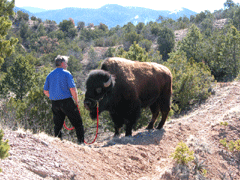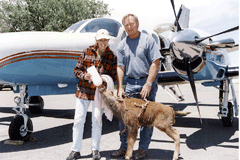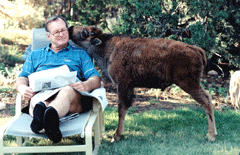A Buffalo in the House
Air Date: Week of August 3, 2007

Roger takes Charlie out on the trail for a little exercise. (Courtesy of R.D. Rosen.)
Roger Brooks and Veryl Goodnight never intended to keep a buffalo as a permanent guest in their suburban Sante Fe home, but that's what happened. Host Steve Curwood talks with the subjects of a new book by R.D. Rosen, called "A Buffalo in the House."
Transcript
CURWOOD: Over a century ago, the Texas ranch of Charles and Mary Ann Goodnight played a critical role in saving the southern bison herd from extinction. Mrs. Goodnight convinced her husband to take in some baby buffalo that had been orphaned, and raise them on the ranch. Their story inspired artist and distant relative Veryl Goodnight. She wanted to make a sculpture depicting a rancher's wife bottle-feeding a baby buffalo, just like Mary Ann Goodnight once did. The hitch was, she needed a live model. Veryl Goodnight and her husband, Roger Brooks, found their model in a less than a week old abandoned buffalo calf named Charlie. But Charlie, as it turns out, would become a much bigger part of their lives. The story is chronicled in a new book by R.D. Rosen called "A Buffalo in the House." With me now are Veryl Goodnight and Roger Brooks. Hello, there.
GOODNIGHT: Hi there.
BROOKS: Hello Steve.
CURWOOD: Or maybe I should say howdy.
GOODNIGHT: Howdy, we are out West.
CURWOOD: The sculpture is of a baby bison. So it doesn’t take very long for him to well, you know, not be needed any longer as your model right Veryl?
GOODNIGHT: My idea was to borrow this baby buffalo to use him for a model and then return him up to the ranch. I sculpted him when he was about a month old so it went fairly quickly. I was done with him in about a month, six weeks, somewhere around there but in the mean time Roger and Charlie had fallen in love with each other. So, the idea of returning him met with some resistance.
CURWOOD: I’m assuming at the time you got the baby buffalo that maybe he weighs 100 pounds or something. But this is a critter that’s going to weigh what 2200 pounds, a ton.

Roger and Veryl pick up Charlie in Idaho. (Courtesy of R.D. Rosen)
CURWOOD: Paralyzed.
BROOKS: Yeah.
GOODNIGHT: Quadriplegic and they thought that Charlie’s legs could possibly come back. So, he stayed at the hospital for a month and sure enough he was able to get up again on his own but he could never be pasture sound. He could never be out with other buffalo.
CURWOOD: So you now have yourself a 400 no maybe 500, on its way to 2200 pound pet.

A nosey bison teen! (Courtesy of R.D. Rosen)
BROOKS: That’s right. We had never intended to make a pet out of him. But we not only had one but one that could really barely walk and took a lot of rehabilitative care.
CURWOOD: So, what’s it like to live with a buffalo?
BROOKS: Oh, gee I could look out my office window and see him out there and it just you know was always very heartening. To be able to lay down beside a big beast like this and to relate on a level, a common level that we found was an experience in my mind that could not be matched.
CURWOOD: Roger, you can go ahead and tell me. You’d cuddle up with Charlie like a big buffalo blanket?
BROOKS: (laughs) Well, I would lay down beside him at times, absolutely and I could scratch him and, gee when I’d scratch his belly he’d even lift a leg so that I could get a better scratch on him. One thing that to me is interesting is that I could touch any part of his body accept for his horns. His horns were sacred and I needed permission to touch them.
CURWOOD: Roger, how do you get permission from a buffalo to touch his or her horns?
BROOKS: (laughs) Well, you definitely need their trust and you have to ask and a lot of times you have to ask repeatedly. Charlie’s first answer to any question was no. And then you started a negotiating process. When we were out hiking Charlie would sometimes stop and basically tell me, “well, I’m not going to leave here forever.” And” Charlie, well gee why don’t we go just a little bit forward?” “No.” “Well, Charlie, ok the we’ll stay here.” You just let a little bit of time pass and then negotiate with him and most of the time I could get my way but it took a lot of patience.

Roger takes Charlie out on the trail for a little exercise. (Courtesy of R.D. Rosen.)
CURWOOD: I’m thinking of those bison horns and um, you read stories about other people that have had bison pets or tried to keep them at least around the corral and there’s more than one story where they wind up getting impaled on those.
BROOKS: That was always there. I never went in with Charlie without realizing I was going in with a wild animal. One thing, Steve, that I feel to describe the balance that I had to have with Charlie is that I could not let him dominate me. If he dominated me, he would hurt me. It would just be very natural with him. But I could not dominate him more than the slightest amount because if I dominated him unfairly he would resent me and he would hurt me.
CURWOOD: Veryl, what was it like watching Roger and Charlie’s relationship grow?
GOODNIGHT: The intensity of the relationship between the two of them was beyond anything that I and most animal lovers have ever experienced. I think part of it is Roger. I mean he’s big, athletic man’s man combined with this big powerful bull bison. I mean it’s a relationship that I could never duplicate. It was very exciting, not that at times I wasn’t jealous of it. I’m going to have to admit to that. (laughs) But I think I was more jealous of the relationship than I was jealous of Charlie. I love Charlie too, very, very much.

Meet n’ Greet. (Courtesy of R.D. Rosen)
GOODNIGHT: Well, we lost him at the age of three, Steve. I think I better tell this because Roger still gets choked up. Charlie continued to have a week neck. When he was three he got his head stuck under the lowest rail in the arena. Roger was home alone and had to get him up with the aid of the fire department. But he got him up but Charlie was back down again in a couple of days. And if they’re down on their side for long they get fluid in their lungs. And Charlie did and he contracted pneumonia and we lost him.
CURWOOD: There’s a saying that life is what happens along the way to the plans that we have and usually what happens is way different. What’s the best thing that happened to you as a consequence of having Charlie come into your life?
GOODNIGHT: Charlie was a gift. I think Richard Rosen sums it up beautifully in his book if I could just read one sentence here. He said, “It was as if this gentle wounded buffalo had been sent out among people so that they could touch and smell a world that had been left behind, so that they might enter gracefully into nature.”
CURWOOD: Roger?
BROOKS: I don’t know Steve, how I can answer that. I was so honored to share part of my life with this big bull bison. And his loss to me was more sorrowful to me than even the loss of my parents. So, you know it’s one of life’s unique opportunities. People have those in various forms and living Charlie was mine.
CURWOOD: Well, I want to thank you for taking this time with me. Veryl Goodnight and Roger Brooks are the subjects of the book, “Buffalo in the House” by R. D. Rosen. Thank you both.
GOODNIGHT: Thank you.
BROOKS: You’re welcome, Steve. Thank you.
[MUSIC: The Californians “Home on the Range” ‘Western Songs and Trail Ballads’ (Digital Musicworks International, Inc. – 2006)]
CURWOOD: Veryl Goodnight and Roger Brooks moved from Sante Fe, New Mexico to southwestern Colorado, where there is a buffalo herd nearby. Roger Brooks is now active in efforts to protect the bison of Yellowstone.
Links
Living on Earth wants to hear from you!
Living on Earth
62 Calef Highway, Suite 212
Lee, NH 03861
Telephone: 617-287-4121
E-mail: comments@loe.org
Newsletter [Click here]
Donate to Living on Earth!
Living on Earth is an independent media program and relies entirely on contributions from listeners and institutions supporting public service. Please donate now to preserve an independent environmental voice.
NewsletterLiving on Earth offers a weekly delivery of the show's rundown to your mailbox. Sign up for our newsletter today!
 Sailors For The Sea: Be the change you want to sea.
Sailors For The Sea: Be the change you want to sea.
 The Grantham Foundation for the Protection of the Environment: Committed to protecting and improving the health of the global environment.
The Grantham Foundation for the Protection of the Environment: Committed to protecting and improving the health of the global environment.
 Contribute to Living on Earth and receive, as our gift to you, an archival print of one of Mark Seth Lender's extraordinary wildlife photographs. Follow the link to see Mark's current collection of photographs.
Contribute to Living on Earth and receive, as our gift to you, an archival print of one of Mark Seth Lender's extraordinary wildlife photographs. Follow the link to see Mark's current collection of photographs.
 Buy a signed copy of Mark Seth Lender's book Smeagull the Seagull & support Living on Earth
Buy a signed copy of Mark Seth Lender's book Smeagull the Seagull & support Living on Earth

